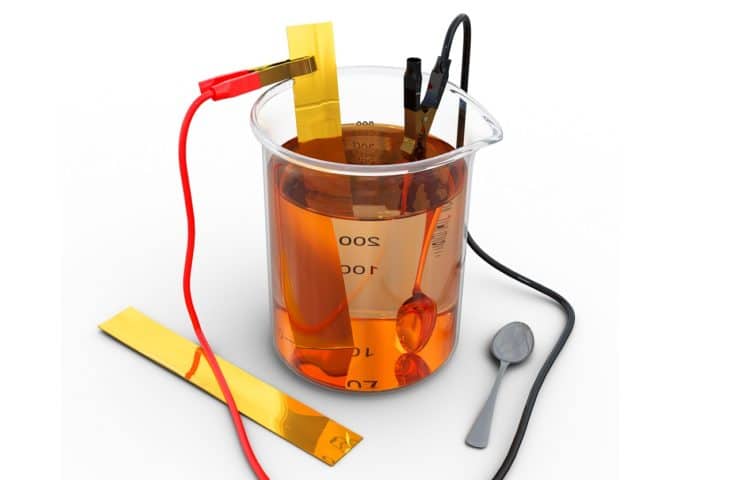

Gold Electroplating is a method of depositing a thin layer of gold onto the surface of another metal. Gold plating solutions are the chemical components needed for gold electroplating to take place.
Gold plating uses an alkaline gold plating solution to deposit gold onto a metal substrate by electrolysis. Traditionally, such a solution is prepared using extremely poisonous cyanide compounds which are reasonably restricted because they are poisonous and must be dispensed in a very restrictive manner. We will be using publicly available chemicals, which are not as toxic as the cyanide compounds but can still be poisonous.
Gold plating solutions should not be done unsupervised as some components can be extremely poisonous. This blog will give instructions to make an alkaline gold plating solution that can deposit gold by electrolysis.
Below are the steps to be followed to make a gold plating solution:
If you already have nitric acid at a concentration of 50% or above, you can skip this step. Otherwise, here is how to make yours.
Gold can either be dissolved using aqua regia or royal water, which is nitric acid, combined with hydrochloric acid at a ratio of 1:3. Hydrochloric acid is commercially available as muriatic acid. Since nitric acid is restricted, it must be prepared using available chemicals.
There are quite a few ways to make nitric acid under laboratory conditions. We will be showing two ways.
One way of preparing nitric acid is by catalyzing a reaction of sodium nitrate with sulphuric acid and distilling the mixture to reduce acid to a concentration higher than 90%. At this concentration level, nitric acid becomes highly corrosive and will produce fumes of toxic nitrogen dioxide gas.
Another less dangerous way is concentrating very dilute nitric acid that is commercially available to the public. You can use fractional distillation to concentrate nitric acid from 30% to 50% concentration.
Gold chloride can be made by dissolving gold in aqua regia. These two components’ reaction produces toxic fumes, so the process is conducted under a fume hood or outdoors. Gold will dissolve in around 20 minutes at room temperature. The reaction will be a solution of dissolved gold, copper compounds, and solid crystals of silver salts. Filtration will separate the liquid from the solids. Gold will then be precipitated out of the solution by adding a sodium metabisulfite solution. The final step will be the separation of the solid gold to be dissolved again in aqua regia. The acid needs to be evaporated at 120°C to obtain the red gold chloride crystals.
For this final step, a strongly alkaline solution of gold chloride and potassium Ferro cyanide is needed. The solution and the electric current will allow gold to be deposited over the surface of another metal. This solution contains gold cyanide ions, which are extremely poisonous. Under no circumstances can the solution be mixed with acids, as it will release hydrogen cyanide gas. Which is so toxic, words are insufficient.
Making gold plating solution is no business of a novice, please exercise caution.
Gold plating is a luxurious way to elevate the look of your belongings, and with the 24K Brush Gold Plating Solution from Goldgenie, you can achieve a professional finish right at home. This cobalt-hardened, acid gold electroplating solution deposits a layer of pure 24K gold onto a conductive surface, ensuring a brilliant and consistent gold plate. With a high gold content and a blend of hardeners and brighteners, this solution is not only efficient in minimizing waste but also offers a long lifespan for your plating needs. Moreover, the absence of harmful free cyanide makes it a safer choice for DIY enthusiasts.
You can easily achieve a flawless 24K gold finish with the innovative 24K Brush Gold Plating Solution from Goldgenie. This solution provides a convenient and efficient way to add a touch of luxury to various items using professional-grade gold plating techniques.
With a high gold content and a specialized blend of hardeners and brighteners, the 24K Brush Gold Plating Solution ensures a consistent and durable gold plate. The cobalt-hardened, acid gold electroplating solution is designed for maximum efficiency, minimizing waste while maximizing the gold deposited on your items. Each 8oz jar contains 2 grams of fine gold, guaranteeing a long lifespan for your plating solution.
Utilizing a cyanide-free formula in the gold plating solution not only ensures the safety of the user and environment but also enhances the quality of the final gold finish. By eliminating harmful free cyanide, the solution offers a safer plating process without compromising on the brilliance and durability of the gold plate. This feature makes the 24K Brush Gold Plating Solution a responsible and reliable choice for achieving professional-looking gold-plated results.
With the right tools, achieving a flawless 24K gold finish is within reach. Components of Brush Plating Kits play a crucial role in the gold plating process. These kits typically include a stainless steel anode, a meter for voltage monitoring, conductive wires, and a low-voltage DC power supply. Each component is vital for creating a successful electroplating circuit and ensuring a uniform gold plate on your item.
Gold plating with 24K Brush Gold Plating Solution requires a proper power source and voltage regulation to achieve optimal results. The power source, along with voltage regulation between 3-5 volts, is crucial for controlling the deposition of gold onto the surface. Proper voltage regulation ensures consistent and even plating, preventing issues like uneven coverage or damage to the item being plated. It’s important to invest in a reliable power source and monitor the voltage throughout the plating process for a professional-looking finish.
Your first step in preparing for the gold plating process is to ensure that the surface you plan to plate is clean and free of any dirt, grime, or oils. Any contaminants on the surface can hinder the adhesion of the gold plating. Begin by degreasing the item using a suitable cleaning agent. Next, polish the surface to a high shine using a polishing cloth or abrasive materials as needed. This will not only enhance the appearance of the final gold plating but also ensure a smooth, conductive surface for the plating process.
The process of achieving optimal electrical connectivity is crucial for successful gold plating. Make sure that the item you’re plating and the stainless steel anode is securely connected to the power source using conductive wires. With a good electrical connection, the current will flow smoothly during the plating process, resulting in a uniform and durable gold finish. Monitor the voltage using a meter and adjust it as needed to maintain the desired plating quality.
All successful gold plating starts with proper preparation of the surface. Ensure your item is clean, degreased, and polished before beginning the plating process. Here is a step-by-step breakdown of applying 24K Brush Gold Plating:
| Step 1 | Prepare the Surface |
| Step 2 | Set Up Your Equipment |
| Step 3 | Apply the Brush Gold Plating Solution |
| Step 4 | Monitor and Adjust Voltage |
| Step 5 | Finish and Inspect |
Plating issues can arise during the gold plating process. Some common problems include uneven plating, dull finish, or adhesion issues. To troubleshoot these, ensure your surface is properly prepped, your equipment is functioning correctly, and the plating solution is fresh. Adjust voltage settings, double-check connections, and experiment with application techniques. If problems persist, consult with Goldgenie for expert advice and support.
Plating issues can occur during the gold plating process, affecting the quality of the final finish. If you encounter issues like uneven plating, dull spots, or poor adhesion, it’s imperative to address them promptly. These problems can often be resolved by ensuring proper surface preparation, equipment maintenance, and solution freshness. Always follow manufacturer guidelines, monitor the voltage closely, and troubleshoot systematically to achieve the best results.
Transforming your items with a luxurious 24K gold finish is easier than ever with Goldgenie’s 24K Brush Gold Plating Solution. This cobalt-hardened, acid gold electroplating solution allows you to achieve professional results at home with the right tools and preparation. With its high gold content and a special blend of components, this solution ensures a beautiful, consistent gold plate while minimizing waste. By using the recommended Brush Plating Kits and preparing your item’s surface properly, you can add elegance and value to your objects. Whether you’re revitalizing old jewelry or personalizing a cherished item, this solution offers a rewarding way to achieve a flawless 24K gold finish with ease.
A: 24K Brush Gold Plating Solution is a cobalt-hardened, acid gold electroplating solution available in liquid or gel form. It deposits a layer of pure 24K gold onto a conductive surface using electricity. The solution contains high gold content, special hardeners, brighteners, and other components for a beautiful, consistent gold plate. It is formulated for efficiency, minimizing waste, and maximizing gold deposition. Each 8oz jar contains 2 grams of fine gold and is free of harmful cyanide.
A: In addition to the 24K Brush Gold Plating Solution, you will need a stainless steel anode (positive electrode), a meter to monitor voltage (set between 3-5 volts), conductive wires to connect the anode and cathode, and a low-voltage DC power supply for brush plating. Proper preparation of the surface you plan to gold plate is necessary, involving cleaning, degreasing, and polishing to ensure a good electrical connection.
A: With the right preparation and equipment, a 24K Brush Gold Plating Solution can add a touch of luxury to various items. Whether you are refreshing old jewelry, giving a new shine to home decor pieces, or personalizing a treasured item, this solution offers a professional-looking 24K gold finish. It’s a rewarding way to enhance the elegance and value of your possessions.

